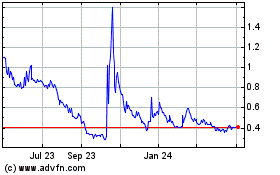CORRECTING and REPLACING Chinese Millennials and Generation Z Set to Become the Dominant Force in Luxury by 2025
December 15 2017 - 3:29AM
Business Wire
Reissuing release to add ticker symbol for searching
purposes.
The corrected release reads:
CHINESE MILLENNIALS AND GENERATION Z SET TO BECOME THE
DOMINANT FORCE IN LUXURY BY 2025
Chinese millennials and Generation Z are set to become the
dominant driver of luxury consumption over the next decade.
The country's millennials (born 1985 to 1995) and Generation Z
(born after 1995) accounted for 34% of discretionary disposable
income in 2015 but this is forecast to rise to 50% by 2025,
according to the 2017 Chinese Luxury E-Commerce Whitebook report
from Secoo (Nasdaq: SECO), Asia's largest high-end e-commerce
platform, and Tencent, the largest data company in China.
The report – which leverages Secoo's unique insight into
customers and Tencent's expertise in big data – found that almost
half (48%) of luxury shoppers in China were under 30.
Young generation embrace online
Some 42% of Chinese millennials tend to shop online, compared
with 34% of Generation X (born between mid 1960s and early 1980s).
The average age is now 25 and, as the desire of young people to
shop online shows no abating, this post-90s generation is also
becoming another powerful group in luxury consumption.
Minority brands Rise up
This younger generation is highly active using online and social
media channels, such as Weibo and WeChat – with digital media
accounting for 76% of where they source the latest luxury
information and insight, while traditional media only accounts for
24%.
Chinese consumers are stepping up their buying of minority
brands – as opposed to famous and high-profile logo – as they seek
more personalised and less mainstream experiences. For example, as
Hip-Hop culture has gradually become more mainstream this has led
to more young people embracing and becoming fans of brands, such as
Supreme and Vetements.
Reduced import duties boost China's domestic
consumption
The US remains the biggest market globally accounting for 22% of
luxury sales but China is a close second with 21%.
The report also found that growth in the Chinese luxury market
is forecast to grow each year by 4% over the next five years to
reach of 617 billion RMB in 2021, ahead of growth in the worldwide
market.
Key drivers behind this have included the Chinese government
introducing policies to stimulate demand for domestic luxury
consumption by reducing import duties on categories, such as
cosmetics, luggage and apparel.
The 2017 China Luxury E-Commerce Whitebook report follows Secoo
reporting strong financial results in 5 consecutive quarters. For
the third quarter to 30 September 2017, Secoo’s GMV reached
US$209.6 million, representing an increase of 65.4% from Q3 2016.
Total net revenue reached US$147.6 million, up 44.2% from Q3
2016.
Secoo has grown rapidly to become Asia’s largest online luxury
transaction platform, according to Frost & Sullivan.
* The content for the 2017 China Luxury E-Commerce Whitebook was
collected between 1 October 2016 and 30 September 2017 and features
a combination of Secoo's real shopping data, mapped against
Tencent's digital and social media data from consumers, including
videos they have been watching. The report also includes data and
research from Deloitte, Euromonitor International and the Fortune
Character Institute.
View source
version on businesswire.com: http://www.businesswire.com/news/home/20171208005297/en/
SECOO GroupTingting Wang, communication@secoo.com
Secoo (NASDAQ:SECO)
Historical Stock Chart
From Mar 2024 to Apr 2024

Secoo (NASDAQ:SECO)
Historical Stock Chart
From Apr 2023 to Apr 2024
